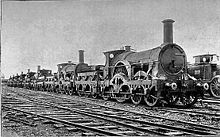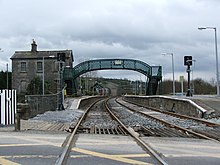Broad-gauge railway
| By transport mode | ||||||||||||||||||||||||||||||||||||||||||||||||||||||||||||||||||||||||||||||||||||||||||||||||||||||||||||||||
|---|---|---|---|---|---|---|---|---|---|---|---|---|---|---|---|---|---|---|---|---|---|---|---|---|---|---|---|---|---|---|---|---|---|---|---|---|---|---|---|---|---|---|---|---|---|---|---|---|---|---|---|---|---|---|---|---|---|---|---|---|---|---|---|---|---|---|---|---|---|---|---|---|---|---|---|---|---|---|---|---|---|---|---|---|---|---|---|---|---|---|---|---|---|---|---|---|---|---|---|---|---|---|---|---|---|---|---|---|---|---|---|---|
| By size (list) | ||||||||||||||||||||||||||||||||||||||||||||||||||||||||||||||||||||||||||||||||||||||||||||||||||||||||||||||||
| ||||||||||||||||||||||||||||||||||||||||||||||||||||||||||||||||||||||||||||||||||||||||||||||||||||||||||||||||
| Change of gauge | ||||||||||||||||||||||||||||||||||||||||||||||||||||||||||||||||||||||||||||||||||||||||||||||||||||||||||||||||
| By location | ||||||||||||||||||||||||||||||||||||||||||||||||||||||||||||||||||||||||||||||||||||||||||||||||||||||||||||||||

| ||||||||||||||||||||||||||||||||||||||||||||||||||||||||||||||||||||||||||||||||||||||||||||||||||||||||||||||||
Broad gauge railways use a rail gauge (distance between the rails) greater than the standard gauge of Template:4ft8.5in.
Overview
| Gauge | Names and usage | |
|---|---|---|
| Imperial | Metric mm | |
| 4 ft 10 in | 1473 | Ohio gauge |
| 4 ft 107⁄8 in | 1495 | Toronto subway and streetcar |
| 4 ft 119⁄10 in | 1520 | Russian gauge and Peak Tram of Hong Kong |
| 5 ft | 1524 | Finland, most U.S. southern states before the American Civil War, Panama Canal until standardized in 1999, Eastern Counties Railway in England until 1844 |
| 5 ft 21⁄4 in | 1581 | Philadelphia streetcars in U.S. [1] |
| 5 ft 21⁄2 in | 1588 | Pennsylvania Trolley gauge, see Southeastern Pennsylvania Transportation Authority subway cars, Southeastern Pennsylvania Transportation Authority streetcars and New Orleans streetcars [2] |
| 5 ft 3 in | 1600 | Irish broad gauge, Victorian broad gauge, South Australian broad gauge, Brazilian broad gauge, Canterbury Provincial Railways gauge |
| 5 ft 41⁄2 in | 1638 | Baltimore (U.S.) Streetcar System (defunct) [3] |
| 5 ft 55⁄8 in | 1668 | Iberic gauge, Portugal and Spain (Renfe). Usually rounded to Template:5ft6in. |
| 5 ft 6 in | 1676 | India, Sri Lanka, Pakistan, BART in U.S., Canada (Grand Trunk Railway, St. Lawrence and Atlantic Railroad and the Champlain and St. Lawrence Railroad until 1873) The Grand Trunk Railway of Canada collections |
| 5 ft 87⁄8 |
1750 [4] |
Line from Paris to Limours via Saint-Rémy-lès-Chevreuse, France until 1891 |
| 6 ft | 1828 | Erie Railroad, United States, until about 1880 |
| 6 ft 45⁄8 in | 1945 | Netherlands, Dutch broad gauge, 1839-1866 |
| 7 ft 1⁄4 in | 2140 | Great Western Railway and associated companies in England and Wales (until 1892), also harbour railways at Portland, Dorset (England), Holyhead (Wales), Ponta del Garda (Azores), East London (South Africa). |
For a more complete list see: List of broad gauges, by gauge and country
Details

In Britain the Great Western Railway designed by Isambard Kingdom Brunel pioneered broad gauge from 1838 with a gauge of Template:7ft, and retained this gauge until 1892.
While Parliament was initially prepared to authorise lines built to the broad gauge, it was eventually rejected by the Gauge Commission in favour of all railways being built to Standard Gauge for compatibility. Broad gauge lines were gradually converted to dual gauge or standard gauge from 1864, and finally the last of Brunel's broad gauge was converted in 1892.
Many countries have broad gauge railways. Ireland (see History of rail transport in Ireland) and some parts of Australia have a gauge of Template:5ft3in (but Luas, the Dublin light rail system, is built to standard gauge). Russia and the other former Soviet Republics use a 1520 mm (originally Template:5ft) gauge while Finland continues to use the Template:5ft) gauge inherited from Imperial Russia (the two standards are close enough to allow full interoperability between Finland and Russia).

In 1839, the Netherlands started its railway system with two broad gauge railways. The chosen gauge was 1945 mm after a visit of engineers in England. This was applied between 1839–1866 by the Hollandsche IJzeren Spoorweg-Maatschappij (HSM) for their Amsterdam-The Hague-Rotterdam line and between 1842–1855, firstly by the Dutch state, but soon by the Dutch Rhenish Railway Co. (NRS) for their Amsterdam-Utrecht-Arnhem line. But the neighboring countries Prussia and Belgium used already standard gauge so the two companies had to regauge their first lines. In 1855, NRS regauged its line and shortly after connected to the Prussian raiways. The HSM followed in 1866. There are replicas of one broad gauge 2-2-2 locomotive (De Arend) and three carriages in the Dutch Railway Museum in Utrecht. These replicas were built for the 100th anniversary of the Dutch Railways in 1938–39.
The Baltic states have received funding from the European Union for rebuilding their railways to the standard gauge. Portugal and the Spanish Renfe system use a gauge of 5 ft 5½ in (1668 mm) called "Ancho Ibérico" (see Rail gauge). In India a gauge of Template:5ft6in is widespread. This is also used by the Bay Area Rapid Transit (BART) system of the San Francisco Bay Area. In Toronto, Canada the TTC subways and streetcars use a unique gauge of 4 feet 10 7/8 inches (1495 mm), an "overgauge" originally intended to allow standard gauge horse-drawn wagons to run inside the rails while the streetcars ran on top of them.
Most non-standard broad gauges get in the way of interoperability of railway networks. On the GWR, the Template:7ft gauge was supposed to allow for high speed, but the company had difficulty with locomotive design in the early years (which threw away much of their advantage), and rapid advances in permanent way and suspension technology saw standard gauge speeds approach broad gauge speeds within a decade or two in any case. On the Template:5ft3in and Template:5ft6in gauges, the extra width allowed for bigger inside cylinders and greater power, a problem solvable by outside cylinders and higher steam pressure on standard gauge. On BART, the wider gauge is supposed to prevent lightweight trains from being blown over by the wind.[citation needed]
The British Raj in India adopted Template:5ft6in gauge, although some standard gauge railways were built in the initial period. The standard gauge railways were soon converted to broad gauge. Reputedly, broad gauge was thought necessary to keep trains stable in the face of strong monsoon winds. Attempts to economise on the cost of construction lead to the adoption of Template:1m gauge and then Template:2ft6in and Template:2ft narrow gauges for many secondary and feeder lines.
However broad gauge remained the most prevalent gauge across the Indian subcontinent, reaching right across from Iran to Burma and Kashmir to Tamil Nadu. After Independence, the Indian Railways adopted Template:5ft6in as the standard Indian Gauge, and began Project Unigauge to convert metre gauge and narrow gauge to broad gauge. Even the newest rail projects in India, such as the Konkan Railway and the Delhi Metro use broad gauge. There was a move to use standard gauge for the Delhi Metro, but the decision was made to use broad gauge to maintain compatibility with the rest of the rail network in India.
Selection of Russian wide gauge
Although it is a popular myth that Russian gauge was selected wider to prevent railroad invasion, this is not true. Russian gauge of 5 ft was approved as the new standard on September 12 1842. However the USSR never standardized their gauge based on military reasons. The break-of-gauge prevented railroads from being the primary method of logistics and forcing a more costly motorized style of logistics. Furthermore the USSR employed much heavy equipment that the broad gauge was well suited to transport and which could not be effectively transported over her substandard motor-way infrastructure. The selection process was done chiefly by Mel'nikov. Probably, a combination of the following arguments was used:
- Easier construction of locomotives
- Better stability
- Wide gauge was seen as a new standard that was emerging in the United States
- Since the gauge was wider than standard road track it was easier to use horse carriages for railroad construction and maintenance.
George Washington Whistler was invited as a foreign expert to assist in railroad construction. He was a proponent of a wider gauge and his efforts helped in lobbying the new standard. It is quite likely that an "invasion" argument (alleging that it is easier to adapt trains to narrow gauge than to wide gauge) was used in lobbying the project since military was closely supervising the construction; however, it is highly unlikely that such an argument was made by Mel'nikov during the actual selection process. Nazi Germany suffered such problems with their supply lines during World War II as a result of the break-of-gauge.
Although broad gauge was and is quite rare on lighter railways and street tramways, many tramways in ex-USSR were and are also built to broad gauge (according to terminology in use in these countries, gauges narrower than 1520 mm are considered to be narrow). The former Soviet Union is today the largest operator of first generation tramways in the world, and has been for many years. The modern world's largest tramway network, in Saint Petersburg, Russia, is entirely broad gauge, with some of the world's widest trams, and indeed the widest in Europe (European trams are generally narrower than European buses and trains and also tramcars elsewhere such as America and Australia).
Overcoming a break of gauge
Where trains encounter a different gauge (a break of gauge), such as at the Spanish-French border or the Russian-Chinese one, the traditional solution has always been transshipment — transferring passengers and freight to cars on the other system. This is obviously far from optimal, and a number of more efficient schemes have been devised. One common one is to build cars to the smaller of the two systems' loading gauges with bogies that are easily removed and replaced, with switching of the bogies at an interchange location on the border. This still takes a few minutes per car, but remains quicker than transshipment. A more modern and sophisticated method is to have multigauge bogies whose wheels can be moved inward and outward. Normally they are locked in place, but special equipment at the border unlocks the wheels and pushes them inward or outward to the new gauge, relocking the wheels when done. This can be done as the train moves slowly over special equipment.
When transhipping from one gauge to another, chances are that the quantity of rolling stock on each gauge in unbalanced, leading to more idle rolling stock on one gauge than other.
In some cases, breaks of gauge are avoided by installing dual gauge track, either permanently or as part of a changeover process to a single gauge. In other cases (in Spain) variable gauge axles are used.
Broader gauges
Some applications for railways require broader gauges, including:
- Telescopes
- Rocket launchers - USSR used double track 5' 0" gauge; US prefers trackless Caterpillar trucks.
- Dockside cranes for unloading cargo from ships and for constructing ships
- Ship railways
These applications might use double track of the country's usual gauge to provide the necessary stability and axle load. These applications may also use much heavier than normal rails, the heaviest rails for actual trains being about 70kg/m.
See also
|

